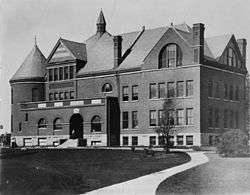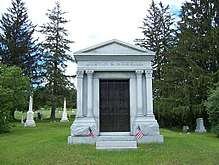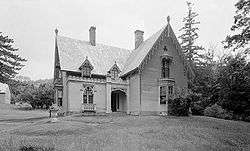Justin Smith Morrill
Justin Smith Morrill (April 14, 1810 – December 28, 1898) was a Representative (1855–1867) and a Senator (1867–1898) from Vermont, most widely remembered today for the Morrill Land-Grant Acts that established federal funding for establishing many of the United States' public colleges and universities. He was one of the founders of the Republican Party.[1]
Justin Smith Morrill | |
|---|---|
 Morrill pictured between 1855 and 1865 | |
| United States senator from Vermont | |
| In office March 4, 1867 – December 28, 1898 | |
| Preceded by | Luke P. Poland |
| Succeeded by | Jonathan Ross |
| Chairman of the House Republican Conference | |
| In office March 4, 1863 – March 3, 1867 | |
| Speaker | Schuyler Colfax |
| Preceded by | Office established |
| Succeeded by | Robert C. Schenck/ Nathaniel P. Banks (1869) |
| Chairman of the House Committee on Ways and Means | |
| In office March 4, 1865 – March 3, 1867 | |
| Preceded by | Thaddeus Stevens |
| Succeeded by | Robert C. Schenck |
| Member of the U.S. House of Representatives from Vermont's 2nd district | |
| In office March 4, 1855 – March 3, 1867 | |
| Preceded by | Andrew Tracy |
| Succeeded by | Luke P. Poland |
| Personal details | |
| Born | April 14, 1810 Strafford, Vermont, US |
| Died | December 28, 1898 (aged 88) Washington, D.C., US |
| Political party | Whig, Republican |
| Spouse(s) | Ruth Barrell Swan (1821–1898) |
| Profession | Businessman |
| Signature | |
Early life
Born in Strafford, Vermont, Morrill attended the common schools, Thetford Academy and Randolph Academy. He was trained for a business career by working as a merchant's clerk in Strafford and Portland, Maine. He then was a merchant in Strafford, and the partnership in which he participated with Judge Jedediah H. Harris grew to own and operate four stores throughout the state.[2] Morrill also served in local offices including Town Auditor and Justice of the Peace.[3]
One of Judge Harris's daughters married Portus Baxter, who also served in Congress. Baxter and Morrill became close friends as a result of the connection to Judge Harris, with Morrill referring to Baxter as "one of nature's noblemen" and Baxter consciously patterning his business and political career on Morrill's.[4]
Morrill invested in several successful ventures, including banks, railroads, and real estate. By the late 1840s he was financially secure enough to retire, and he became a gentleman farmer.[5]
In addition to farming, Morrill became active in the Whig Party, including serving as Chairman of the Orange County Whig Committee, a member of the Vermont State Whig Committee, and a Delegate to the 1852 Whig National Convention.[6]
Congressional career
_(cropped).jpg)
In 1854 Morrill was elected to the Thirty-fourth Congress as a Whig. He was a founder of the Republican Party, and won reelection five times as a Republican, serving from March 4, 1855 to March 3, 1867. He served as chairman of the Committee on Ways and Means in the Thirty-ninth Congress. He also served on the Joint Committee on Reconstruction, which drafted the Fourteenth Amendment to the United States Constitution.
In 1866 Morrill was elected to the U.S. Senate as a Union Republican. He was reelected as a Republican in 1872, 1878, 1884, 1890, and 1896, and served from March 4, 1867, until his death, almost thirty-one years. He served as chairman of the Committee on Public Buildings and Grounds (Forty-first through Forty-fourth Congresses) where he played a vital role in obtaining the current Library of Congress main building through his work on the Joint Select Committee on Additional Accommodations for the Library. He also served as chairman of the Committee on Finance (Forty-fifth, Forty-seventh through Fifty-second, Fifty-fourth and Fifty-fifth Congresses). In addition, Morrill was a regent of the Smithsonian Institution from 1883 to 1898 and a trustee of the University of Vermont from 1865 to 1898.
Legislation

The Morrill Tariff of 1861 was a protective tariff law adopted on March 2, 1861. Passed after anti-tariff southerners had left Congress during the process of secession, Morrill designed it with the advice of Pennsylvania economist Henry C. Carey.[7] It was one of the last acts signed into law by James Buchanan, and replaced the Tariff of 1857.[8] Additional tariffs Morrill sponsored were passed to raise revenue during the American Civil War.[9]
Morrill is best known for sponsoring the Morrill Act, also known as the Land Grant College Act. This act was signed into law by Abraham Lincoln in 1862, and established federal funding for higher education in every state of the country. In his own words:
This bill proposes to establish at least one college in every State upon a sure and perpetual foundation, accessible to all, but especially to the sons of toil, where all of needful science for the practical avocations of life shall be taught, where neither the higher graces of classical studies nor that military drill our country now so greatly appreciates will be entirely ignored, and where agriculture, the foundation of all present and future prosperity, may look for troops of earnest friends, studying its familiar and recondite economies, and at last elevating it to that higher level where it may fearlessly invoke comparison with the most advanced standards of the world.
— Justin Smith Morrill, 1862, as quoted by William Belmont Parker, The Life and Public Services of Justin Smith Morrill
He also authored the Morrill Anti-Bigamy Act of 1862, which targeted The Church of Jesus Christ of Latter-day Saints, based on the then-existing practice of plural marriage (polygamy). It imposed a five-hundred dollar fine and up to five years imprisonment for the crime of polygamy. On January 6, 1879, in Reynolds v. United States the Supreme Court, upheld the Anti-Bigamy Act's ban on plural marriage.[10][11][12]
A second Land Grant College Act in 1890 targeted the former Confederate states and led to the creation of several historically black colleges and universities.[13]
The Land Grant College Acts ultimately led to the founding of 106 colleges including many state universities, polytechnic colleges, and agricultural and mechanical colleges.[14]
Personal

In 1851, Morrill married Ruth Barrell Swan (1822–1898) of Easton, Massachusetts. They had two children. Justin Harris Morrill (1853–1855) died in childhood. James Swan Morrill (1857–1910) graduated from the University of Vermont in 1880 and Columbian College Law School in 1882. He was a lawyer and farmer and served in a variety of offices including as a member of the Vermont House of Representatives.[15][16][17][18] He wrote Self-Consciousness of Noted Persons, published in 1886.[19]
Morrill died in Washington, D.C. on December 28, 1898.[20] He was buried at Strafford Cemetery.[21]
At the time of Morrill's death his 43 years and 299 days of continuous Congressional service was the longest in U.S. history. He has since been surpassed, but still ranks 18th as of March 2014.[22]
Legacy
The Justin Smith Morrill Homestead in Strafford is a National Historic Landmark.[23]
Many colleges established under the Morill Act created a 'Morrill Hall' in his honor.[24]
Morrill was initiated into the Delta Upsilon fraternity as an honorary member in 1864.[25] He received honorary degrees from the University of Vermont, University of Pennsylvania, Dartmouth College, and many other institutions.[26]
Justin Morrill College at Michigan State University was named for him.[27]
In 1962, the U.S. Postal Service issued a 4 cent postage stamp to celebrate the centennial of the Morrill Land-Grant College Act. In 1999, the Postal Service issued a 55 cent Great Americans series postage stamp of Morrill to honor his role in establishing the land grant colleges.[28]
In 1967 Ohio State University opened two residence halls on its campus. Named for Morrill and Abraham Lincoln, they are also known as The Towers.[29] They are the tallest buildings on the OSU campus, and among the tallest in Columbus Ohio.
References
- McCarthy, Daniel (2008-05-05) Fewer Bases, More Baseball Archived 2011-04-30 at the Wayback Machine, The American Conservative
- Hiram Carleton, Genealogical and Family History of the State of Vermont, Volume 1, 1903, page 83
- Richard Zuczek, Encyclopedia of the Reconstruction Era, Volume 2, page 422
- William Belmont Parker, The Life and Public Services of Justin Smith Morrill, 1924, page 52
- Coy F. Cross II, Coy F. Cross, Justin Smith Morrill: Father of the Land-Grant Colleges, 2012
- Alfred Charles True, A History of Agricultural Education in the United States: 1785–1925, 1929, page 95
- Cynthia Clark Northrup, Elaine C. Prange Turney, Encyclopedia of Tariffs and Trade in U.S. History, 2003, page 265
- Alvin S. Felzenberg, The Leaders We Deserved (and a Few we Didn't), 2010, page 190
- Bob Navarro, The Country in Conflict, 2008, page 105
- Michael S. Durham, Desert Between the Mountains, 1999, page 199
- Richard Neitzel Holzapfel, The Utah Journey, 2009, page 211
- Gordon Morris Bakken, editor, Law in the Western United States, 2000, page 292
- Roger L. Geiger, editor, History of Higher Education Annual, 1998, page 81
- Epsilon Sigma Phi, Land Grant Universities Archived 2014-03-11 at the Wayback Machine, retrieved March 10, 2014
- Hiram Carleton, Genealogical and Family History of the State of Vermont, Volume 1, 1903, page 85
- Vermont Secretary of State, Legislative Manual, 1902, page 107
- Washington Post, James S. Morrill Dead, July 29, 1910
- George Washington University, General Alumni Catalogue of George Washington University, 1917, page 174
-

- Leonard C. Schlup, James G. Ryan, Historical Dictionary of the Gilded Age, 2003, page 321
- Inter-state Journal magazine, The Morrill Mausoleum, September 1900, page 3
- U.S. Senate Art & History, Biography of Justin Smith Morrill, retrieved March 10, 2014
- U.S. Government Printing Office, House Resolution 1253, Commemorating the 200th anniversary of the birth of Vermont Senator Justin Smith Morrill, April 14, 2010
- Robert F. Wilson, Vermont Curiosities: Quirky Characters, Roadside Oddities & Other Offbeat Stuff, 2008
- Delta Upsilon fraternity, The Delta Upsilon Quarterly, Volume 11, 1892, page 30
- D. Appleton and Company, Appleton's Annual Cyclopedia and Register of Important Events, 1898, page 559
- Michigan State University, College of Arts and Letters, Justin Morrill College, 1965–1979 Archived 2014-03-10 at the Wayback Machine, retrieved March 10, 2014
- Cornell University, Senator Justin S. Morrill: The Land-Grant College Act and Cornell, retrieved March 10, 2014
- Deitch, Linda (January 9, 2013). "Due south of Ohio Stadium (late 1940s)". Columbus Dispatch. Retrieved 5 April 2015.
Further reading
- Cross, Coy F. Justin Smith Morrill Father of the Land-Grant Colleges. Michigan State University Press: 1999. ISBN 978-0-87013-508-8.
- Memorial Address on the Life and Character of Justin S. Morrill. Government Printing Office: 1899.
External links
| Wikisource has the text of a 1911 Encyclopædia Britannica article about Justin Smith Morrill. |
- United States Congress. "Justin Smith Morrill (id: M000969)". Biographical Directory of the United States Congress.. Includes Guide to Research Collections where his papers are located.
- Works by or about Justin Smith Morrill at Internet Archive
- Justin Smith Morrill at Find a Grave
- "An Audacious Act: How A High School Dropout Helped Educate America" produced by WFCR New England Public Radio and journalist, Lisa Mullins
- NDSU shrine to Morrill
- Vermont Division for Historic Preservation
- Friends of the Morrill Homestead
- Justin Morrill: Land For Learning Documentary produced by Vermont Public Television
Archives and records
- Justin S. Morrill papers at Baker Library Special Collections, Harvard Business School.
| U.S. House of Representatives | ||
|---|---|---|
| Preceded by Andrew Tracy |
Member of the U.S. House of Representatives from Vermont's 2nd congressional district March 4, 1855 – March 3, 1867 |
Succeeded by Luke P. Poland |
| U.S. Senate | ||
| Preceded by Luke P. Poland |
U.S. senator (Class 3) from Vermont March 4, 1867 – December 28, 1898 Served alongside: George F. Edmunds and Redfield Proctor |
Succeeded by Jonathan Ross |
| Preceded by John Sherman |
Chairman of the U.S. Senate Committee on Finance 1877–1879 |
Succeeded by Thomas F. Bayard |
| Preceded by Thomas F. Bayard |
Chairman of the U.S. Senate Committee on Finance 1881–1893 |
Succeeded by Daniel Voorhees |
| Preceded by Daniel Voorhees |
Chairman of the U.S. Senate Committee on Finance 1895–1898 |
Succeeded by Nelson Aldrich |


